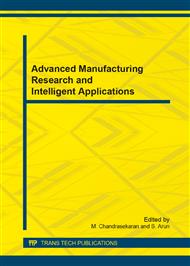[1]
F. L. Matthews and R. D. Rawlings, Composite Muterials ; Engineering cmd Science, Chapman and Hall. London, (1994).
Google Scholar
[2]
Hepworth DG, Vincent JFV, Jeronimidis G, Bruce DM. The penetration of epoxy resin into plant fibre cell walls increases the stiffness of plant fibre composites. Composites Part A 2000; 31: 599–601.
DOI: 10.1016/s1359-835x(99)00097-4
Google Scholar
[3]
Rosa MF, Chiou BS, Merdeiros ES, Wood DF, William TG, Mattoso LHC, et al. Effect of fibre treatments on tensile and thermal properties of starch/ethylene vinyl alcohol copolymers/coir biocomposites. Bioresour Technol 2009; 100: 196–202.
DOI: 10.1016/j.biortech.2009.03.085
Google Scholar
[4]
Fu S-Y, Lauke B. Effects of fibre length and fibre orientation distributions on the tensile strength of short-fibre-reinforced polymers. Compos Sci Technol 1996; 56: 1179–90.
DOI: 10.1016/b978-0-08-102623-6.00005-6
Google Scholar
[5]
Tungjitpornkull S, Sombatsompop N. Processing technique and fibre orientation angle affecting the mechanical properties of E-glass fibre reinforced wood/PVC composites. J Mater Process Technol 2009; 209: 3079–88.
DOI: 10.1016/j.jmatprotec.2008.07.021
Google Scholar
[6]
B. Vijaya Ramnath, C. Vinodh Krishna, S. Karthik, K. Saravanan, VM. Manickavasagam, C. Elanchezian; Evaluation of flexural properties of pineapple reinforced polymer composite for automotive and electrical applications; Advanced Material Research 893, 271 (2014).
DOI: 10.4028/www.scientific.net/amr.893.271
Google Scholar
[7]
R. Niranjan Raja , B. Vijaya Ramnath, S. Junaid Kokan, R. Sathya Narayanan, S. Rajesh, VM. Manickavasagam; Fabrication and testing of abaca fiber reinforced epoxy composites and tested for automotive applications; Advanced Material Research 718-720, 63 (2013).
DOI: 10.4028/www.scientific.net/amr.718-720.63
Google Scholar
[8]
R. Niranjan Raja , B. Vijaya Ramnath, S. Junaid Kokan, R. Sathya Narayanan, S. Rajesh, C. Elanchezhian; Properties and performance analysis of woven roving composite laminates for automotive panel board applications; Advanced Material Research 683, 21 (2013).
DOI: 10.4028/www.scientific.net/amr.683.21
Google Scholar
[9]
B. Vijaya Ramnath, S. Junaid Kokan, R. Niranjan Raja, R. Sathya Narayanan, C. Elanchezhian, A. Rajendra Prasad, VM. Manickacasagam; Evaluation of mechanical properties of abaca-jute-glass fiber reinforced epoxy composite; Materials and Design 51, 357 (2013).
DOI: 10.1016/j.matdes.2013.03.102
Google Scholar


